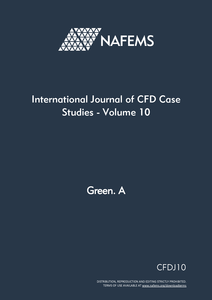 | The papers in this 10th volume of the Journal offer a wide range of CFD application topics each presenting comparisons with experiment as validation. |
Technical textile fabrics have many uses, one such use, is in the paper making industry. In the paper by Farber et al water needs to flow through a textile with specific properties, requiring much trial testing of the fabric structure. A technique of “weaving” single cylindrical filaments together is used to create a small sample of a commercial fabric. The sample is used to simulate an experimental set up where water flows through the fabric and velocities are compared to Magnetic Resonance Imaging results.
Friction stir welding of metals is a new technology with equipment design largely relying on empirical data from welding performance tests. The process is highly non-linear comprising complex heat transfer, metal plastic deformation and flow. Simulating the welding tool at the plunge, dwell and traverse stages allows a better understanding of the process and parameters. The paper by Mackenzie et alcalculates transient temperature distributions and metal flow visualizations in the welding process.
Lifeboats launched from ships and offshore platforms must avoid overloading the occupants and vessel hull. A computational method using overlapping grids, to simplify the handling of lifeboat motion and specification of initial and boundary conditions, is used in the paper by Mørch et al to calculate vessel accelerations and pressures. The achieved accuracy in numerical simulations is comparable to the accuracy of experiments and provides a new design evaluation method.
Sanding systems are used to prevent a tram skidding on the rails, keeping sand used to a minimum.Simulating a sand-air mixture requires modelling the behaviour of the sand particles on the surface of the rails. A stochastic sub-model described in the paper by Möller et al, tuned using in-house experiment results, led to an improved design of the sanding device and sand jet which were later tested.
Water is inevitable in aircraft fuel tanks and aircraft movements create waves or “slosh” the fuel and water interface. Removing the water requires the positioning of scavenge pick-up locations to be optimised. The paper by Hylands et al uses CFD to simulate the dynamic motion of two liquids in a rectangular tank and compared to flow visualisation and pressure data results from a sloshing test rig.
Three of the papers mention the desire to make CFD the preferred method of analysis, the experimental approach is variously described as laborious, time-consuming, costly and requiring many optimisation tests. This is an old debate – “CFD replaces the wind tunnel” was mooted thirty years ago and we are still waiting! Most CFD practitioners realise that both are currently required for real engineering design - the challenge is to understand where each technique may augment the other.
Information
| Reference: | CFDJ10 |
| Author: | Green. A |
| Published: | 1st June 2013 |
| Audience: | Analyst |
| Language: | English |
| ISSN: | 1462-236X |
| ISBN: | 978-1-910643-94-5 |
| https://doi.org/10.59972/52ge55zl | |

Stay up to date with our technology updates, events, special offers, news, publications and training
If you want to find out more about NAFEMS and how membership can benefit your organisation, please click below.
Joining NAFEMS© NAFEMS Ltd 2025
Developed By Duo Web Design